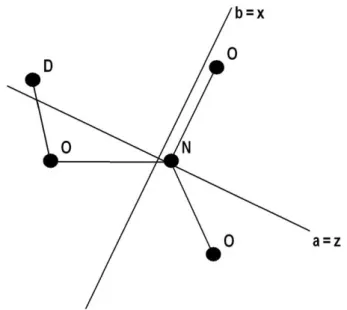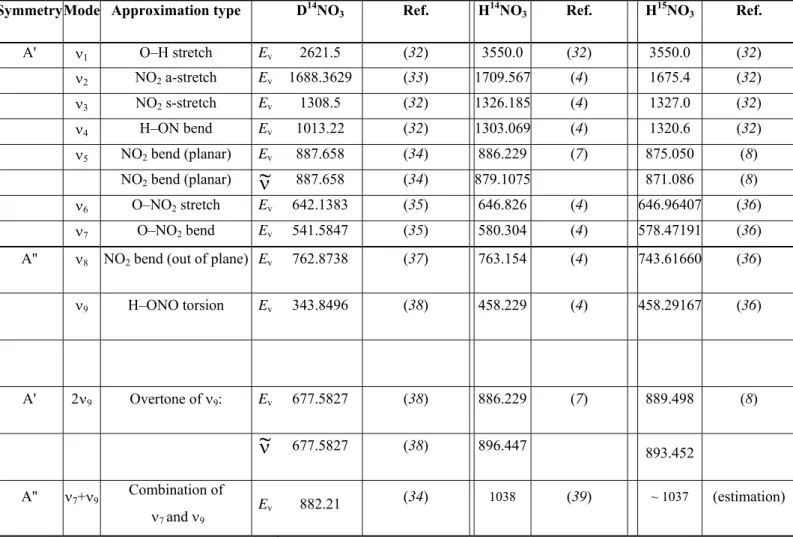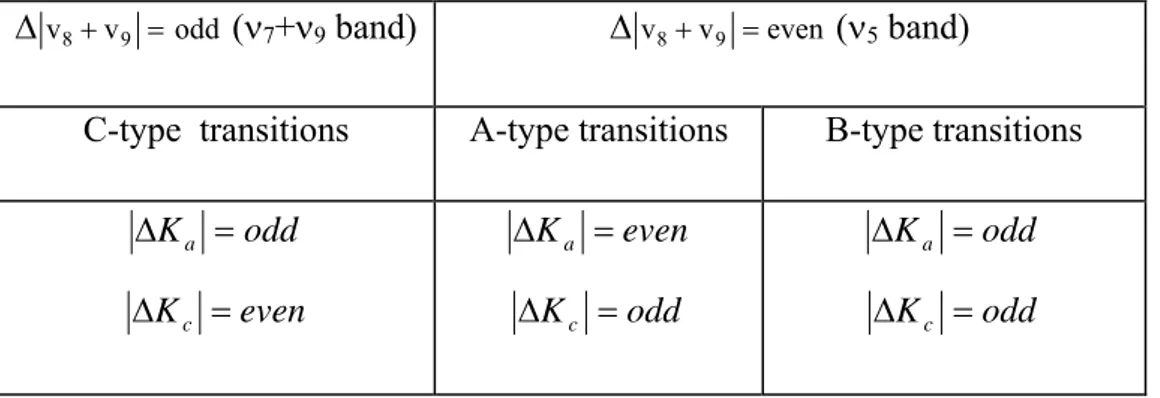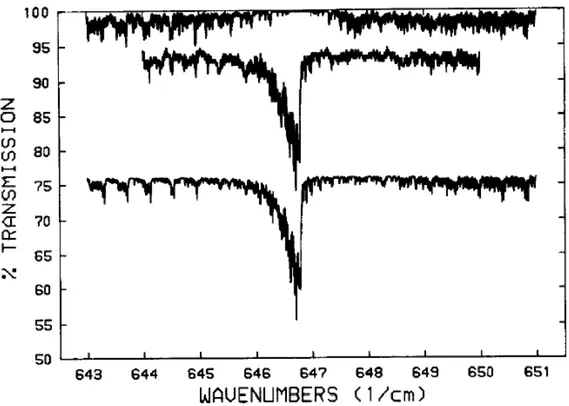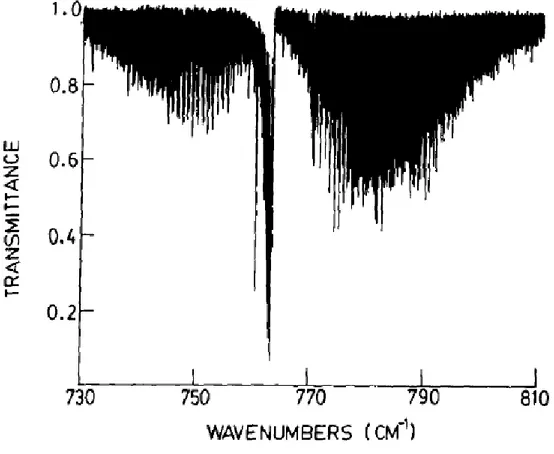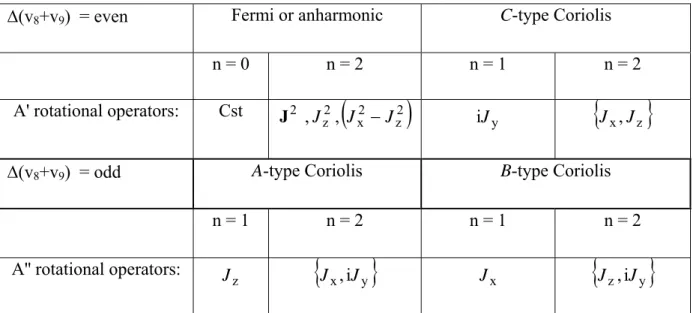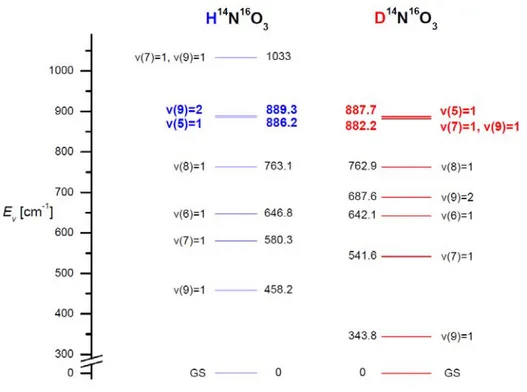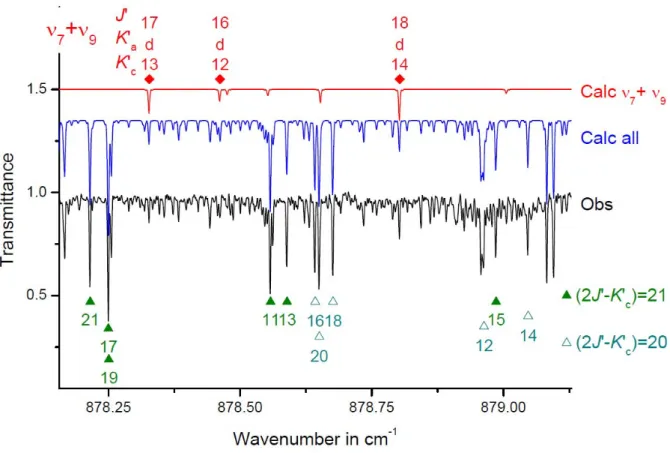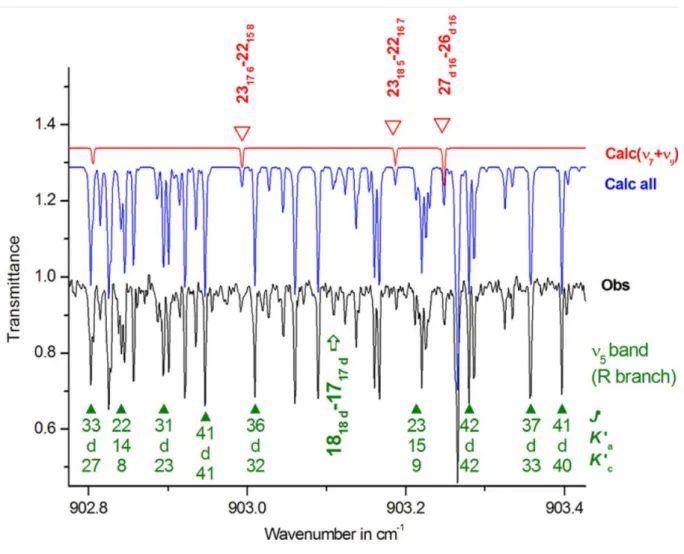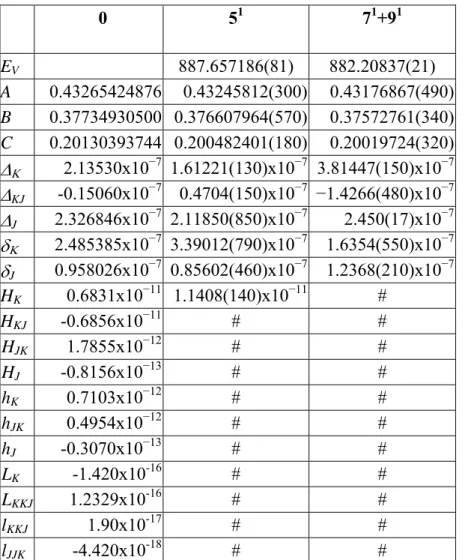HAL Id: tel-00674500
https://tel.archives-ouvertes.fr/tel-00674500
Submitted on 27 Feb 2012HAL is a multi-disciplinary open access archive for the deposit and dissemination of sci-entific research documents, whether they are pub-lished or not. The documents may come from teaching and research institutions in France or abroad, or from public or private research centers.
L’archive ouverte pluridisciplinaire HAL, est destinée au dépôt et à la diffusion de documents scientifiques de niveau recherche, publiés ou non, émanant des établissements d’enseignement et de recherche français ou étrangers, des laboratoires publics ou privés.
Rovibrational study of DNO3 nu5 band and collisional
effect studies of CH3F microwave spectra with and
without Stark effect
Jindrich Koubek
To cite this version:
Jindrich Koubek. Rovibrational study of DNO3 nu5 band and collisional effect studies of CH3F microwave spectra with and without Stark effect. Atmospheric and Oceanic Physics [physics.ao-ph]. Université Paris-Est, 2011. English. �NNT : 2011PEST1093�. �tel-00674500�
THESE DE DOCTORAT Présentée et soutenue publiquement
pour obtenir le titre de docteur des UNIVERSITE PARIS-EST
et
ECOLE SUPERIEURE DE TECHNOLOGIE CHIMIQUE DE PRAGUE par
Jindřich KOUBEK
Sujet: Etude rovibrationnelle de la bande ν5 de DNO3 et l´étude des effets collisionnels
dans les spectres microonde de CH3F sans et sous effet Stark
Soutenue le 15 Septembre 2011 devant le Jury composé de: M. C. Boulet Prof. Dr., Université Paris-Sud, Orsay Président M. F. Thibault Dr., MCf HDR Université de Rennes I, Rennes Rapporteur M. P. Pracna Dr., Institut J. Heyrovský AS RT, Prague Rapporteur M. J.-M. Hartmann Dr., DR CNRS, LISA, Créteil Examinateur
Mme A. Perrin Dr., DR CNRS, LISA, Créteil Co-Directeur de thèse M. Š. Urban Prof. Dr., ESTC Prague, Prague Co-Directeur de thèse
Thèse en co-tutelle : Université Paris-Est (France) et Ecole Supérieure de technologie chimique de Prague (République Tchèque), préparée au LISA à Créteil (CNRS UMR 7583, Universités Paris Est-Créteil et Paris Diderot) et au LMSVR à Prague (Département de Chimie Analytique, ESTC).
Universite Paris-Est
Ecole doctorale: SIE – Sciences, Ingénierie et Environnement
Spécialité: Physique
Co-directrice de thèse: A. Perrin (DR, CNRS, LISA)
Ecole Supérieure de technologie chimique de Prague
Faculté de l’Ingénierie Chimique, Département de Chimie Analytique
Programme: Chimie
THESIS
presented and publicly defended to obtain the doctorate degree of
UNIVERSITE PARIS-EST and
INSTITUTE OF CHEMICAL TECHNOLOGY, PRAGUE by
Jindřich KOUBEK
Subject: Rovibrational study of DNO3 ν5 band and collisional effect studies of
CH3F microwave spectra with and without Stark effect
Defended on 15th of September 2011 in front of a Jury composed of: Mr. C. Boulet Prof. Dr., Université Paris-Sud, Orsay President Mr. F. Thibault Prof. Dr., Université de Rennes I, Rennes Reviewer Mr. P. Pracna Dr., J. Heyrovský Institute AS CR, Prague Reviewer Mr. J.-M. Hartmann Dr., DR CNRS, LISA, Créteil Member Mrs. A. Perrin Dr., DR CNRS, LISA, Créteil Co-Advisor Mr. Š. Urban Prof. Dr., ICT Prague, Prague Co-advisor
Co-tutelle thesis: Université Paris-Est (France) and Institute of Chemical Technology, Prague (Czech Republic), prepared in LISA in Créteil (CNRS UMR 7583, Universités Paris Est-Créteil et Paris Diderot) and in LMSVR in Prague (Department of Chemical Analysis, ICT).
Universite Paris-Est
Graduate school: SIE– Sciences, Ingénierie et Environnement Speciality: Physics
Thesis co-advisor: A. Perrin (DR, CNRS, LISA)
Institute of Chemical Technology, Prague
Faculty of Chemical Engineering, Department of Analytical Chemistry Program: Chemistry
Domain: Analytical Chemistry
DISERTAČNÍ PRÁCE k získání doktorského titulu
UNIVERSITE PARIS-EST a
VYSOKÁ ŠKOLA CHEMICKO-TECHNOLOGICKÁ V PRAZE
Vypracoval a veřejně obhájil Jindřich KOUBEK
Téma: Rovibrační studie pásu ν5 DNO3 a studie kolizních efektů v
mikrovlnných spektrech CH3F pod vlivem a bez vlivu Starkova jevu
Obhájeno 15. září 2011 před komisí ve složení:
C. Boulet prof. Dr., Université Paris-Sud, Orsay Předseda F. Thibault prof. Dr., Université de Rennes I, Rennes Oponent P. Pracna Dr., Ústav J. Heyrovského AV ČR, Praha Oponent J.-M. Hartmann Dr., DR CNRS, LISA, Créteil Zkoušející A. Perrin Dr., DR CNRS, LISA, Créteil Školitelka Š. Urban prof. Dr., VŠCHT Praha, Praha Školitel
Dizertační práce byla vypracována v rámci doktorátu pod dvojím vedením (co-tutelle) na Université Paris-Est (Francie) a Vysoké škole chemicko-technologické v Praze (Česká republika), v laboratořích LISA (CNRS UMR 7583, Universités Paris Est - Paris Diderot, Créteil) a LMSVR (Ústav analytické chemie, VŠCHT Praha). Université Paris-Est
Škola PGS: SIE– Sciences, Ingénierie et Environnement
Specializace: Fyzika
Školitelka co-tutelle: A. Perrin (DR, CNRS, LISA)
Vysoká škola chemicko-technologické v Praze
Fakulta chemicko-inženýrská, Ústav analytické chemie
Studijní program: Chemie
Résumé
Le travail qui est présenté dans ce mémoire de thèse s’inscrit dans le domaine de la Spectroscopie moléculaire en phase gazeuse théorique et expérimentale. Il comprend deux parties dédiées à des aspects relativement différents de cette discipline.
La première partie présente l’analyse à haute résolution des positions et intensité des raies de la bande ν5 (ouverture angulaire du groupe NO2 dans le plan de la molécule) de DNO3 dans la
région spectrale de 11 µm. Pour ce faire, nous avons utilisé un spectre infrarouge enregistré dans la région 700−1400 cm−1 à l’aide d’un spectromètre à transformée de Fourier de l’université « Bergische Universität » à Wuppertal, en Allemagne. Ce travail nous a permis de montrer que la bande ν5, centrée à 887.657 cm−1, est fortement perturbée. L’analyse
prouve en effet que les niveaux d’énergie 51 et 71+91 sont couplés par des résonances de Coriolis de types A et B. Le schéma de résonances pour la variété isotopique DNO3 diffère
donc fortement de ceux observés pour les états 51 et 92 de H14NO3 et H15NO3 qui
sont majoritairement de type Fermi.
Le deuxième problème abordé dans ce travail est celui des profils de raies rotationnelles pures de CH3F avec l’étude des élargissements collisionnels (collisions CH3F-CH3F et CH3
F-He) des transitions optiques et de leurs composantes Stark. Des mesures microondes ont été réalisées à l’ESTC à Prague. Leur analyse a permis d’en extraire des paramètres collisionnels à l’aide de divers profils de raies (Voigt, Rautian, dépendantes de vitesse) pour les transitions
J, K → J + 1, K (K = 0, …, J) avec J = 1 et J = 3 et leurs diverses composantes Stark J, K, M → J + 1, K, M’ (|M| = 0, …, J ; |M − M’| = 0, 1). De plus, un modèle fondé sur
l’approximation Infinite Order Sudden (IOS) a été construit pour décrire les effets d’interférences collisionnelles observés. Les résultats expérimentaux obtenus complètent et étendent des travaux précédents et sont la première démonstration de la capacité de l’approximation IOS à modéliser les couplages collisionnels entre composantes Stark.
Mots clefs: DNO3, spectroscopie infrarouge, positions, intensités, résonance Coriolis,
bande ν5, bande ν7 + ν9, CH3F, spectroscopie microonde, profils de raies, profil de Rautian,
profil avec dépendance de vitesse, élargissement collisionel, effet Stark, moment dipolaire, couplage des raies, approximation IOS.
Summary
The work presented in this thesis belongs to the domain of theoretical and experimental gas phase molecular spectroscopy. It consists of two parts dedicated to two relatively different aspects in this field.
The first part presents a high resolution analysis of the ν5 fundamental band (NO2 in plane
bending mode) positions and intensities of D14NO3 (deuterated nitric acid) in the 11 µm
spectral region. For this study, we used an infrared spectrum of D14NO
3 recorded in the
700−1400 cm−1 region on a Fourier transform spectrometer at Bergische Universität in
Wuppertal (Germany). Our analysis demonstrates that the fundamental ν5 band centered at
887.657 cm−1 is strongly perturbed. Indeed, it proves that 51 and 71+91 energy levels of DNO3
are coupled through A and B type Coriolis resonances. The resonance scheme for the isotopologue D14NO3 therefore differs substantially from the schemes of H14NO3 and H15NO3
that feature dominantly Fermi type resonances.
The second theme treated in this work is devoted to the lineshapes of pure rotational transitions of CH3F with the study of collisional broadening (collisions CH3F-CH3F and
CH3F-He) of optical transitions and their Stark components. The microwave measurements
were realised at ICT in Prague. Their analysis enabled to provide collisional parameters using various line profiles (Voigt, Rautian, Speed dependent) for the J, K → J + 1, K (K = 0, …, J) transitions with J = 1 and J = 3 as well as for their various Stark components
J, K, M → J + 1, K, M’ (|M| = 0, …, J ; |M − M’| = 0, 1). Moreover, a correct use of model
based on Infinite Order Sudden approximation led to very satisfactory results of the observed line-mixing effects. The retrieved experimental results complete and extend the previous studies and provide the first successful demonstration of the ability of the IOS approximation to model line-mixing effects among Stark transitions.
Key words: DNO3,Infrared spectroscopy, Positions, Intensities, Coriolis resonance, ν5 band,
ν7 + ν9 band, CH3F, Microwave spectroscopy, Line shapes, Rautian profile, Speed dependent
Shrnutí
Předkládaná dizertační práce tematicky zahrnuje jak teoretickou, tak i experimentální molekulovou spektroskopii v plynné fázi. Předmětem práce jsou dvě relativně nezávislé studie, které spojuje právě zaměření na vysoce rozlišenou spektroskopii plynů.
V první části je vypracována analýza poloh a intenzit linií vysoce rozlišeného spektra základního vibračního pásu ν5 (mód kyvadlové rovinné vibrace skupiny NO2) DNO3 v 11 µm
spektrální oblasti. V této studii bylo použito infračervené spektrum naměřené v rozsahu 700−1400 cm−1 na FT spektrometru v Bergische Universität ve Wuppertalu (Německo). Tato práce ukazuje, že základní pás ν5 o poloze 887.657 cm−1 je silně porušen. Podrobná
analýza naměřených spekter dokázala, že energetické hladiny 51 a 71+91 jsou spřaženy prostřednictvím Coriolisových rezonancí typu A a B. Rezonanční schéma isotopologu DNO3
se tedy podstatně liší od rezonancí pozorovaných u H14NO3 a H15NO3, kde mezi stavy 51 a 92
dominují Fermiho rezonance.
Druhá část práce se věnuje profilům čistě rotačních linií CH3F. Studováno je kolizní rozšíření
(kolize CH3F s CH3F a kolize CH3F s He) rotačních přechodů a jejich Starkových
komponent. Mikrovlnná spektra byla naměřena na VŠCHT Praha. Jejich analýza vedla k určení kolizních parametrů vybraných profilů (Voigtův, Rautianův, rychlostně závislé profily) u přechodů J, K → J + 1, K (K = 0, …, J) s J = 1 a J = 3 a jejich Starkových komponent J, K, M → J + 1, K, M’ (|M| = 0, …, J ; |M − M’| = 0, 1). Navíc byl pro popis pozorovaných kolizních interferenčních jevů sestaven model založený na Infinite Order Sudden (IOS) aproximaci. Získané výsledky doplňují a rozšiřují předchozí práce a jsou zároveň první úspěšnou aplikací aproximace IOS pro modelování kolizního spřažení (line-mixing) mezi Starkovými komponentami.
Klíčová slova: DNO3,infračervená spektroskopie, pozice, intenzita, Coriolisovy rezonance,
pás ν5 , pás ν7 + ν9, CH3F, mikrovlnná spektroskopie, profily linií, Rautianův profil,
rychlostně závislý profil, kolizní rozšíření, Starkův jev, dipólový moment, Line-Mixing, model IOS
Declaration (form as required by ICT Prague)
The thesis work had been carried out at the Department of Chemical Analysis of the Institute of Chemical Technology Prague from September 2007 to September 2011 and in the period from October 2008 to September 2011 also at the Laboratoire Interuniversitaire des Systèmes Atmosphériques (LISA, CNRS, UMR 7583) at Université Paris-Est Créteil in the frame of the program “thèse en co-tutelle”.
„I hereby declare that I have worked out the thesis independently while noting all the resources employed as well as co-authors. I consent to the publication of the thesis under Act No. 111/1998, Coll., on universities, as amended by subsequent regulations. “
Thesis aims (form as required by ICT Prague) The thesis projects aim at three tasks:
1. Analysis of rovibrational spectra of the deuterated nitric acid (DNO3) fundamental
band ν5 with respect to the interactions between states 51 and 7191.
2. Measurement of the methyl fluoride (diluted or not in helium) pure rotational microwave spectra with and without Stark effect.
3. Analysis of the collisional effects observed in the measured spectra of CH3F,
comparison of the Stark lines’ experimental collisional broadening values with those calculated using Infinite Order Sudden (IOS) approximation method.
Acknowledgements
I would like to thank my ancestors, especially mother Věra (in memoriam), father Jindřich and grand mother Marta.
I thank Lucie who had accompanied me abroad for co-tutelle stays, delaying thus her own carrier and projects for a couple of years.
I thank my supervisors Dr. Agnès Perrin and Prof. Štěpán Urban for the interesting yet manageable thesis themes they supported, for attentive care they provided and for their unwavering patience I experienced all along my doctoral studies. I thank Dr. Jean-Michel Hartmann for his original proposal, for his generous help with coding and for his kind long-term supervision of the collisional study on methyl fluoride.
I also thank Prof. Christian Boulet, Prof. Franck Thibault and Dr. Petr Pracna for their participation in the Jury at the thesis defence.
I thank the directors of the respective laboratories or departments (LISA: Dr. Jean-Marie Flaud, Dr. Gilles Bergametti, DAC-402 ICT Prague: Prof. Karel Volka, Prof. Štěpán Urban) for enabling the thesis research projects to be carried out.
I also thank the junior scientists and fellow students for creation of both very friendly and enthusiastic atmosphere be it at LISA (namely Dr. Ha Tran, Dr. Gaëlle Dufour, Vincent Sironneau, Dr. Abdollatyf El Hilali, Dr. Denis Zyryanov, Dr. Maxim Eremenko) or in LMSVR group of DAC-402 (Dr. Lucie Nová-Stříteská, Dr. Tereza Uhlíková, Lucie Kolesniková, Zuzana Meltzerová, Dr. Patrik Kania, Dr. Juraj Varga, Jan Koucký, Michal Rybníček, Pavel Beran, Jan Šťovíček).
For kind and generous support and for sharing their way and life in France, I also thank Grazyna Perl, the Dijon “famille d’acceuil”: Françoise Julien, Jean-Michel Florès, Anny and Joël Pétot and fellow “ex-lycéens“: Petr Škubal and Jan Maršálek.
For dealing efficiently with my “dossier co-tutelle”, I express my thanks to French administration whether based at the Embassy of France in Prague (Dr. Xavier Morise, Xavier Romieu, Hermine Martin), at CROUS de Créteil (Jean-Michel Namur, Katia Kegels), or linked to the doctoral school SIE of the UPE (Prof. Denis Duhamel, Prof. Marie Claire Gazeau, Brigitte David, Auziria Mendes), as well as the persons in administrative positions at ICT Prague, on the Czech side of the co-tutelle: Prof. Bohumil Bernauer, Prof. Marie Urbanová, Dr. Kamila Klaudisová, Svatava Poupětová. I express my gratitude to the grants that helped to sustain materially the realization of projects carried out for this thesis: French Government studentship (Bourse du Gouvernement Français - Bourse de Doctorat en co-tutelle), Bourse de mobilité de la Région Ile-de-France, Soutien aux bourses co-tutelle de l´Université Paris-Est, research programs LC06071 and MSM6046137307 of Ministry of Education, Youth and Sports of the Czech Republic, student grant 402 88 1105 at ICT Prague (financial support from specific university research MSMT No 21/2011).
This thesis project had no traced way at its start and I realize at its end how many people contributed slightly or greatly, in a direct or indirect way to its direction, realization or
Contents
I INTRODUCTION 12
I.1 ROVIBRATIONAL STUDY OF DNO3ν5 BAND 12
I.2 COLLISIONAL EFFECT STUDIES OF CH3F MICROWAVE SPECTRA WITH AND WITHOUT STARK EFFECT 13
II VIBRATION –ROTATION STUDY FOR A MOLECULE OF ATMOSPHERIC AND
THEORETICAL INTEREST: THE CASE OF THE DNO3 ISOTOPOMER OF NITRIC ACID 15
II.1 GENERAL CONSIDERATIONS,ROVIBRATIONAL HAMILTONIAN 16
II.2 APPLICATION TO THE NITRIC ACID MOLECULE 21
II.2.1 Description of the molecule 21
II.2.1.1 Nitric acid structure 21
II.2.1.2 Inertia axes and rotational constants 21
II.2.1.3 Vibration 23
II.2.2 Symmetry properties 24
II.2.2.1 Symmetry group of DNO3 24
II.2.2.2 Symmetry properties of H0 eigenstates 25
II.2.2.2.1 Symmetry of vibrational states 25 II.2.2.2.2 Symmetry of the rovibrational levels 29
II.2.3 Selection rules 29
II.2.4 Contact transformation and energy levels calculation 33
II.2.4.1 Vibrational Hamiltonian 33
II.2.4.2 Rotational Hamiltonian for non resonating states 35
II.2.4.3 Resonance conditions 38
II.2.4.4 Rotational operators appearing in the expansion of the v-off diagonal operators in case of resonances 38 II.2.4.5 Symmetrized basis for energy level calculation 41
II.2.5 Intensities 41
II.2.5.1 Transformed dipolar moment 42
II.2.5.2 Calculation of the line strengths: 43
II.3 FIRST HIGH RESOLUTION ANALYSIS OF THE ν5 BAND OF DNO3 45
II.3.1 Existing spectroscopic studies for the first vibrational states of DNO3 45
II.3.2 Experimental details 46
II.3.3 Analysis 48
II.3.4 Energy levels and intensity calculation 54
II.3.4.1 Hamiltonian 54
II.3.4.2 Resonances 56
II.3.4.3 Intensity calculation 58
II.3.5 Conclusion 59
III CH3F COLLISIONAL EFFECT STUDIES – EXPERIMENTAL PART 60
III.1 EXPERIMENTAL SET-UP 60
III.2 PURE ROTATIONAL TRANSITION MEASUREMENTS 62
III.3 SPECIFICITIES OF THE MEASUREMENTS IN THE SIGNIFICANT EXTERNAL ELECTRIC FIELD 65
IV LINE PROFILES OF PURE ROTATIONAL CH3F LINES 76
IV.1 GENERAL CONSIDERATIONS 76
IV.1.1 Absorption 77
IV.2 INTRODUCTION TO ISOLATED LINES PROFILES 77
IV.2.1 Doppler broadening, Dicke narrowing 78
IV.2.2 Lorentz, Dicke, Voigt, Galatry and Rautian profiles 80
IV.2.3 Speed dependence 83
IV.3 CASE OF CH3F 85
IV.3.1 Introduction 85
IV.3.2 Analysis 86
V LINE-MIXING AMONG CH3F STARK LINES 91
V.1 INTRODUCTION TO COLLISIONAL LINE MIXING 91
V.1.1 Absorption coefficient and widths 93
V.1.2 Construction of the relaxation matrix 95
V.2 CASE OF STARK COMPONENTS OF CH3F AND CH3F IN HE 97
V.2.1 Introduction 97
V.2.2 The IOS relaxation matrix 98
V.2.3 Data 101
V.2.4 Analysis 103
V.2.4.1 Results - Pure CH3F 105
V.2.4.2 Results - CH3F diluted in Helium 109
V.2.5 Conclusion 112
VI CONCLUSION 115
VII REFERENCES 117
VIII APPENDICES 120
VIII.1 APPENDIX 1:DERIVATION OF SPEED DEPENDENT VOIGT PROFILE FORMULA 120
I
Introduction
The work presented in this thesis had been done in the frame of co-tutelle thesis program organized by Université Paris-Est (UPE) and by Institute of Chemical Technology, Prague (ICT Prague). Some studies have been carried out in the Laboratoire Interuniversitaire des Systèmes Atmosphériques (LISA, CNRS UMR 7583) under the supervision of Dr. Agnès Perrin and at the Department of Analytical Chemistry (DAC-402) of ESCT Prague in the laboratory LMSVR under direction of Prof. Štěpán Urban. Another topic of the thesis, suggested at the end of the first year of the co-tutelle, was studied afterwards and continued further on, in cooperation with Dr. Jean-Michel Hartmann (LISA) and Prof. Christian Boulet (ISMO). The text describes therefore two completely independent spectroscopic studies, as the thesis name suggests: an analysis of the infrared spectra of deuterated nitric acid (DNO3)
and an analysis of collisional effects in the Stark and non Stark microwave spectra of the methyl fluoride (CH3F). These two subjects are introduced in the following two sections.
The lay-out of the thesis text is presented afterwards. I.1 Rovibrational study of DNO3 ν5 band
Nitric acid (HNO3) plays an important role as a ‘‘reservoir’’ molecule for both the NOx
(nitrogen oxides) and HOx (hydrogen oxides) species in the stratosphere (1, 2). These radicals
are potentially active contributors to the ozone destruction in the stratosphere through catalytic reactions. The 11 µm region corresponds to one of the strongest absorption bands of nitric acid and coincides with a rather clear atmospheric window of the atmosphere. This spectral region is therefore commonly used for the retrieval of nitric acid in the atmosphere, not only for the most abundant isotopic species (H14NO3, Refs. (3, 4) and
references therein) but also for H15NO
3 (isotopic concentration of about α ~ .00365(7)) which
could be detected by MIPAS (Michelson Interferometer for Passive Atmospheric Sounding) aboard the ENVISAT satellite (5). For this reason, numerous spectroscopic studies were devoted to the improvement of line position, line intensities ((6-9) and references therein) and line broadening parameters (10) for nitric acid at 11 µm for both the H14NO3 and H15NO3
species.
On the other hand, the chances to detect DNO3 in atmospheric spectra at 11 µm are rather
weak. DNO3 exists with rather weak isotopic abundance in a natural sample of nitric acid
(α ~1.55 10-4) and the ν5 band of DNO3 is located at 887.7 cm-1 in the middle of the 11 µm
Q-branches are clearly observable in atmospheric spectra at 879.109, 896.448, 885.424 cm-1, respectively. However studying DNO3 is interesting since it provides input for the validation
of recent and future ab initio studies on nitric acid (11). Indeed the resonance scheme for the interacting DNO3 vibrational states differs as compared to H14NO3 and H15NO3.
I.2 Collisional effect studies of CH3F microwave spectra with and
without Stark effect
Line-mixing (LM) is a process manifesting through transfers of intensity among overlapping optical transitions and resulting from rotational population exchanges induced by inter-molecular collisions. It has been the subject of numerous experimental and theoretical studies for various molecular systems and types of spectra, as reviewed in Chapter IV of Ref. (17). However, few of these studies have considered the case of collisional exchanges among Stark resolved molecular lines, i.e. when an applied electric field removes the spatial degeneracy of the rotational levels. As first shown by Bréchignac (12) and afterwards measured (13-15) for CH3F in the IR region, the “zero field widths” are much smaller than the widths of the
various Stark resolved lines. Various theoretical treatments have been proposed to describe collisional couplings between M-components. Let us first mention the pioneering work of Buffa, Tarrini and co-workers (13), based on a generalization of the well known Anderson-Tsao-Curnutte (ATC) model (16). An alternative approach to take LM into account is to build the associated relaxation matrix using the Infinite Order Sudden (IOS) approximation (17,
18) or its improved Energy Corrected Sudden (ECS) extension (17, 19, 20). IOS/ECS models
have enabled precise modeling of LM effects for many systems and types of spectra (17), including hyperfine components due to nuclear spin (21, 22) and symmetric-top spectra (23,
24). However, quite surprisingly, as shown in Ref. (14), the IOS model developed in (12)
apparently failed to reproduce the details of coupling processes between the Stark components of CH3F lines. With the aim of clarifying this result we have re-examined the
problem and the present work shows that this failure was only due to an oversimplification of the IOS formalism.
During the analysis of the measured CH3F pure rotational spectra using Voigt line shapes, a
“W signature”, characteristic of a narrowing, was observed in the fits residuals. The line shapes were therefore also studied with more refined models that involve a more thorough description of collisional effects by taking Dicke and speed dependence effects into account,
in order to attempt to diminish the residuals and to understand the contributions of various collisional processes.
* * *
The remained of the thesis text is divided into the following parts:
After this introductory chapter, a chapter dedicated to infrared spectra of deuterated nitric acid is presented, in which the general theory is first recalled. Then the model used for the rovibrational spectra of asymmetric top molecules like DNO3 is discussed following the
approach established by J.K.G. Watson for cases with vibrationaly isolated states and generalised further by J.-M. Flaud and C. Camy-Peyret for cases with interacting vibrational states. The final section of the chapter presents the results of the analysis of ν5 band of DNO3
using the previously mentioned formalism.
The next three chapters are devoted to collisional effects on rotational spectra of CH3F.
The third chapter describes the experimental apparatus used for in this study as well as some experimental details on the measurements made using the Stark effect.
The fourth chapter is devoted to the analysis of the shapes of isolated lines in the pure rotational CH3F spectra. Some general theory is first mentioned before some selected models
describing isolated line profiles are discussed. The results obtained CH3F J = 1 and J = 3 pure
rotational transitions are then presented and discussed.
The fifth chapter is devoted to the analysis of the Stark pure rotational CH3F spectra in
situations when lines overlap and collisional line mixing effect get involved. The modelling of this effect using the Infinite Order Sudden (IOS) approximation is detailed before the analysis of Stark and non Stark CH3F (pure or diluted in helium) J = 1 and J = 3 pure
rotational transitions is presented.
II Vibration –rotation study for a molecule of atmospheric and
theoretical interest: the case of the DNO
3isotopomer of
nitric acid
The present chapter is organized in the following way. Paragraph II.1 will describe the overall approximation which led to establish the vibration rotational Hamiltonian written in the form given by Darling and Dennison. Assuming that the nuclei vibrations are small compared to the interatomic distances, the Hamiltonian can be developed in series according to the vibrational quanta. The structure of the DNO3, its vibrational modes, its symmetry
properties will be presented in Paragraph II.2.1 together with the rigid rotor rotational wavefunctions. The selection rules for an electric dipole moment transition will be deduced in Paragraph II.2.3. The “contact transformations” which lead to a partial block diagonalization of the vibration rotation Hamiltonian will be presented in Paragraph II.2.4. Finally the effective Hamiltonian used in this work will be described shortly in Paragraph II.3.4.
II.1 General considerations, Rovibrational Hamiltonian
A molecule can be considered as a rather stable aggregate of atomic nuclei and electrons. The time dependence of Φ(t) is defined by the Schrödinger equation:
)
(
)
(
t
H
t
t
i
=
Φ
∂
Φ
∂
(II.1) where Φ(t) is the molecule wavefunction of the molecule which is function of its electronic and nuclear coordinates. In Eq. (II.1) H is the Hamiltonian of the molecule which is assumed, in the following, to be time independent. In this way the Φ(t) eigenfunctions for the different stationary states are solutions of the equation:)
(
)
(
t
E
t
H
Φ
=
Φ
(II.2)Solving Eq. (II.2) for a molecular system consisting in moving particles (several atoms and numerous electrons) is usually impossible. Several more or less severe approximations must be formulated.
¤ The Born Oppenheimer approximations (25):
The fact that the nuclei are much heavier than electrons (neutron-electron mass ratio
mn/me = 1838.683 6605(11) – 2006 CODATA values (26), proton-electron mass ratio mp/me = 1836.152 672 47(80)) led Born and Oppenheimer (25) to formulate approximation
that fast movements of electrons are separated from the relatively slow movements of nuclei. The rovibronic (electronic vibration rotational) Hamiltonian then takes the form:
evr e vr
H =H +H , (II.3)
where He is electronic Hamiltonian describing the movements of electrons considered for a
given fixed nuclear geometry, and Hvr is the rovibrational (vibration rotational) Hamiltonian
describing the movement of the nuclei for the corresponding electronic state.
In the following of this manuscript, the Born Oppenheimer approximation is assumed to be appropriate. The studies presented here are for molecules (nitric acid and methyl fluoride) in their ground electronic state.
¤ The molecules under study are assumed to be isolated and moving in an isotropic laboratory space. By using a reference system of axes centered at the molecular center of gravity, O, the translation of the center of inertia is completely separated from the internal
coordinates (vibration and rotation) of the molecule. The so-called vibration-rotational Hamiltonian involve 3N − 3 degrees of freedom, for a molecule with N nuclei. We are dealing with non linear polyatomic molecules, and the molecular rotation and the nuclear vibrations around their equilibrium positions are associated to 3 and 3N − 6 degrees of freedom, respectively.
¤ It is assumed that the amplitudes of the nuclei vibrations are small compared to the interatomic distances. This is relevant for the present DNO3 study. Let us mention, however,
that this approximation fails when considering the OH torsional motion (ν9 mode) for the H
isotopomers of nitric acid (H14NO3 and H15NO3).
Even in such conditions, it is not possible to separate completely rotation from the vibration motion. At this level we need to define two orthogonal systems of axes centered at O, the molecular center of gravity: a floating Oxyz - reference system of molecular axis – bound to a
reference molecular configuration (i.e. equilibrium configuration in case of rigid or semi-rigid molecules) and the OXYZ “laboratory fixed” reference system that is in translational
motion relative to the laboratory system. In order to fix the origin, O, of both systems to the center of gravity of the molecule, the following relationship applies:
N i i i 1 m = =
∑
r 0 (II.4)where ri is instantaneous radius vector of nucleus i with mass mi.
In order to minimize the interactions between rotation and vibration, Eckart wrote the following constrains (27) which set the orientation of Oxyz relative to OXYZ :
N 0 i i i i 1 m = ∧ =
∑
r r 0 , (II.5)where ri0 is radius vector of nucleus i at its reference position.
In this way, the vibration-rotation Hamiltonian, as developed by Darling-Dennison (28) takes the following form, presented here as it was simplified later by Watson (29):
(
)
(
)
2 2 , 1 2 2 k k H Jα α αβ Jβ β P U V α β π μ π =∑
− − +∑
+ + (II.6)In this equation, α and β refer to the molecular axes with values x, y or z, k refers to the 3N − 6 normal coordinates Qk. The other symbols are defined as follows:
- παare components on the molecular axes of the vibrational moment defined as: , , 1 k l k l k l Q P α α π =
∑
ς (II.7)- μαβis matrix element (α, β) of the inverse matrix of the effective inertia tensor referring to
the Oxyz molecular system of axis
- P is conjugate moment to the normal coordinate Qk k, and V is the vibrational potential
energy function whose quadratic part can be diagonalized through the 3N − 6 vibrational coordinates: (3 6) 2 1 2 1 ... N k k k V λ Q − = =
∑
+ (II.8) and: - U αα α μ =∑
, (II.9) as shown by J.K.G. Watson (29)In the following of the text, we will use ,qk p which are the dimensionless normal k
coordinates and their conjugate momenta defined by:
1/4 1/2 , k k k k k q Q p i q λ ∂ = = − ∂ (II.10)
In case of small vibrations (in comparison to interatomic distances), V and μαβ can be expanded as series in the normal coordinates qk:
0 1 2 H =H +H +H +… (II.11) with:
(
2 2)
2 0 1 2 k k k k H p q B Jα α α ω =∑
+ +∑
(II.12) 1 2 , 1 , , 2 l k k k l kl klm k l m k k l k k l m H Bα βJ J qα β q p Bα αJα K q q q α β α ω ς ω < < ⎛ ⎞ = − ⎜ ⎟ + ⎝ ⎠∑∑
∑
∑
∑
(II.13)(
)
1(
)
2 , , , , 2 3 8 1 4 k l k l k l k k k k l k klmn k l m n k l m n H q q B B B B B J J B q q J B B K q q q q γα γβ γβ γα αβ γ α β α α β α β γ α β α α α α α π π π − < < < = + − + + − +∑
∑
∑∑
∑
∑
∑
(II.14) In these formulas,- ωk is the harmonic vibrational wavenumber of the kth normal mode:
1/4 2 k k c λ ω π = (II.15)
- Bα is the equilibrium rotational constants (in cm-1 ):
2 8 B cI α α π = (II.16) - , k
Bα β are rotational derivatives:
(
)
2 , 1 0 0 , k k l k l k k l B B B B B B q q q αβ αβ α β γα γβ γβ γα γ μ − ⎛ μ ⎞ ∂ ∂ ⎛ ⎞ =⎜ ∂ ⎟ + = ⎜⎜∂ ∂ ⎟⎟ ⎝ ⎠ ⎝ ⎠ (II.17)- ςklα are Coriolis coupling constants
- πα are components on the molecular axes of the vibrational momentum: 1 2 , , 1 l k l k l k l k q p α α ω π ς ω ⎛ ⎞ = ⎜ ⎟ ⎝ ⎠
∑
(II.18)- Kklm, (resp. Kklmn) are cubic, (resp. quartic) potential constants.
We can rewrite the Eq. (II.12) as:
0 0 0
vib rot
H =H +H , (II.19)
2 0 rot H B Jα α α =
∑
, (II.21)with , , 0vib, 0rot
k B Hα H
ω in cm-1.
The zeroth order Hamiltonian is a rough approximation. At this level, the vibration and rotation are separated, and it is easy to label the vibrorotational energy levels. We will detail the description of the eigenfunctions and eigenvalues of the rotational and vibrational zeroth order Hamiltonian. Let us remind, however, that at higher orders (H1, H2 and over …) the
II.2 Application to the nitric acid molecule
II.2.1 Description of the molecule
II.2.1.1 Nitric acid structure
Figure II.1 gives the structure of nitric acid molecule which is planar in its equilibrium configuration.
Fig. II.1 Scheme of DNO3 structure.
Recently, a semi-experimental equilibrium structure has been derived from experimental ground state rotational constants achieved for several isotopomers of nitric acid ((30), (31) and Refs. therein) and of rovibrational interaction parameters calculated from the ab initio force field. In this way, the best equilibrium structure was found to be
re(N=Osyn) = 1.209(1) Å, re(N=Oanti) = 1.194(1) Å, re(N-O) = 1.397(1) Å, re(O−H) = 0.968(1) Å, ∠(ONOsyn) = 115.8(1)°, ∠(ONOanti) = 114.2(1)° and
∠(NOH) = 102.2(1)° (11).
II.2.1.2 Inertia axes and rotational constants
Figure II.1 gives also the system of principal axes for the DNO3 isotopomer. As compared to
DNO3 is an asymmetric top molecule (it has three different inertial moments). Following the
common usage, the three principal inertial constants are noted as Ba = A, Bb = B and Bc = C
and ordered by the relation A≥ ≥B C.
A (cm-1) B (cm-1) C (cm-1) Ref. H14NO 3 0.43399948 0.40360889 0.2088321 (30) H15NO 3 0.43404204 0.40350885 0.20881543 (31) DNO3 0.43265388 0.37734832 0.2013037 (31)
Table II.1 Ground state rotational constants for the H14NO
3, H15NO3 and D14NO3 isotopomers of nitric
acid.
Table II.1 gives the ground state rotational constants for the H14NO
3, H15NO3 and D14NO3
isotopomers. The following approximation holds:
A~B ~2C (II.22)
Therefore nitric acid may be considered as a “near oblate rotor”.
For a near-symmetric top molecule, it is useful to define the (x,y,z) reference axes, choosing the z axis as the symmetry axis of the rotor. In this way, the standard base J k formed by
eigenvectors common to J2 and z
J is the bases of all rotational wavefunctions.
The eigenstates and eigenvalues of the asymmetric Hamiltonian rotor, 0rot
H , are retrieved by
diagonalization of matrix associated to the standard base J k . Different conventions can be
chosen for the orientation of the (x, y, z) reference system for the symmetric rotor relative to the (a,b,c) inertia axes of the actual molecule. Naturally the IIIr representation, with z = c, x = a, y = b seems the most appropriate for a near oblate molecule like nitric acid, because c
is the z- reference axis. However, the most recent and accurate determinations of the rotational constants for various isotopomers of nitric acid by millimeter wave techniques (30,
31) were satisfactorily performed using a rotational Hamiltonian written in the
Ir representation (x = b, y = c, z = a), and the so called A-type reduction which will be defined
further in the text. Therefore the Ir convention was also adopted in this study. Under these
conditions, the zeroth order rotational Hamiltonian has following form:
2 2 2
0 rot
z x y
The eigenstates of 0rot
H are labeled by J K Ka c, Ka and K being associated, respectively, c
to the components of the total kinetic moment J on molecular axes a and c. Though these
two last labels are not well behaved quantum numbers, nevertheless the triplet J K Ka c (that
follows conditions 0≤Ka ≤ , 0J ≤Kc≤ and J Ka +Kc = orJ J+1) enables labeling of the
molecular rotational energy levels in a single way. Equation of the eigenvalues of 0rot
H has the form:
0 0 0( a c) 0
rot rot
a c J K K a c
H J K K =E J K K (II.24)
II.2.1.3 Vibration
Nitric acid molecule has 3N − 6 = 9 non degenerated vibrations.
Symmetry Mode Approximation type D14NO
3 Ref. H14NO3 Ref. H15NO3 Ref.
A' ν1 O–H stretch Ev 2621.5 (32) 3550.0 (32) 3550.0 (32) ν2 NO2 a-stretch Ev 1688.3629 (33) 1709.567 (4) 1675.4 (32) ν3 NO2 s-stretch Ev 1308.5 (32) 1326.185 (4) 1327.0 (32) ν4 H–ON bend Ev 1013.22 (32) 1303.069 (4) 1320.6 (32) ν5 NO2 bend (planar) Ev 887.658 (34) 886.229 (7) 875.050 (8) NO2 bend (planar)
ν~
887.658 (34) 879.1075 871.086 (8) ν6 O–NO2 stretch Ev 642.1383 (35) 646.826 (4) 646.96407 (36) ν7 O–NO2 bend Ev 541.5847 (35) 580.304 (4) 578.47191 (36)A'' ν8 NO2 bend (out of plane) Ev 762.8738 (37) 763.154 (4) 743.61660 (36)
ν9 H–ONO torsion Ev 343.8496 (38) 458.229 (4) 458.29167 (36) A' 2ν9 Overtone of ν9: Ev 677.5827 (38) 886.229 (7) 889.498 (8)
ν~
677.5827 (38) 896.447 893.452 A'' ν7+ν9 Combination of ν7 and ν9 Ev 882.21 (34) 1038 (39) ~ 1037 (estimation)Table II.2 Vibrational modes of several nitric acid isotopologues. The Ev and
ν~
are the vibrational energyand the band center, respectively, expressed in cm-1.
ν~
is the calculated position for the [J=0, K a=0,Table II.2 gives the description, the frequency, and the symmetry type according to Cs of the
nine vibrational modes of the D14NO3, H14NO3 and H15NO3 isotopologs. The Cs point group
will be defined later in the text.
At zeroth-order, the rotation and vibration are well separated as shown previously ( 0 0vib 0rot
H =H +H ). The eigenstates of H0 are the product of vibrational eigenstate of H0vib
denoted as v v 1 2 … v9 0and of the rotational eigenstate of 0rot
H , denoted as J K Ka c 0: 0 0 0 a c a c J K K = J K K … … 1 2 9 1 2 9 v v v v v v (II.25)
The zeroth-order vibrational Hamiltonian, 0vib
H , is a tensorial product of nine non
degenerated harmonic oscillators. Each corresponding vibrational eigenstate, v v 1 2 … v9 0
is the product of nine vi harmonic oscillators eigenstates. Each associated eigenvalue is the
sum of the nine associated eigenvalues:
0 1 2 9 1 1 1 2 2 2 1 2 9 v v v vib E =ω ⎜⎛ + ⎞⎟+ω ⎛⎜ + ⎞⎟+ +ω ⎛⎜ + ⎞⎟ ⎝ ⎠ ⎝ ⎠ … ⎝ ⎠ (II.26)
II.2.2 Symmetry properties
II.2.2.1 Symmetry group of DNO3
The equilibrium structure of nitric acid has two elements of symmetry: the identity E and the reflection in the molecular plane σxz. Therefore the appropriate symmetry point group is Cs
with Cs =
{
E,σ}
. This point group is isomorph to the G2 = {E, E*}, where E* is theinversion of the positions of all particles (electron and atomic nuclei) in the center of mass. Table II.3 presents the characters of the Cs group together with the symmetry species of the
molecular (μx,μy,μz) and space-fixed (μZ) electric dipole moment components, of the total
angular moment J molecular components, of the normal coordinates, and the rotational levels with regards to the Kc parity.
Cs E σxz [J Ka Kc] G2 E E* μ J Vibrations parity of Kc A' 1 1 μx μy Jz q1,..., q7 even A" 1 -1 μz , μZ Jx Jy q8, q9 odd Table II.3 Symmetry properties of DNO3 molecule
Let us remind that for the H14N16O3 and H15N16O3 isotopomers, the ν9 mode (H–ONO torsion
around the
−
N
<
OO group) is a large amplitude motion. This means that for excited energy levels in the v9 vibrational quantum numbers, splittings of the energy levels can be observed,whose values are of about 2 MHz for v9 = 1, 60 MHz for v9 = 2 and 1800 MHz for v9 = 3.
This is because the ν9 large amplitude motion enables the OO
>
N
−
O
H Ù OO>
N
−
O
Htunneling effects. In this operation, the two 16O in the O
O
N
<
−
radical are exchanged through a (12) permutation. The Cs or G2 groups are no more suitable, and it is necessary to use the G4 = {E, (12), E*, (12)*} permutation-inversion group to characterize the symmetryproperties of the vibration- torsion- rotation wavefunctions. Of course G4 is homomorph onto G2 or Cs.
For DNO3 such large amplitude motions are expected to be significantly weaker than for
HNO3 because of the mass ratio D/H~2. For example the tunneling splitting in the v9 = 2
vibrational state of DNO3 is expected to be only of 2 MHz, instead of 60 MHz for HNO3.
Therefore, the D-O tunneling around the
−
N
<
OO moiety will not be considered for this DNO3 study.II.2.2.2 Symmetry properties of H0 eigenstates
The eigenstates of H0 can also be classified using the two irreducible representations of Cs
group, their type of symmetry Γ (Γ = A' or A'') depends on the parity of the rotational and vibrational quantum numbers and is obtained by multiplication of the types of symmetry of the vibrational state and of the rotational level:
(
J K Ka c 0)
(
0) (
J K Ka c 0)
Γ v v 1 2 … v9 = Γ v v 1 2 … v9 ⊗ Γ (II.27)
Afterwards, it is convenient to calculate the matrix elements of the operators involved in the Hamiltonian using a symmetry adapted basis defined from the J k and v v 1 2 … v9 0.
II.2.2.2.1 Symmetry of vibrational states
The Cs symmetry group is an Abelian group and the type of symmetry of a particular
(
v v 1 2 v9) (
v 1) (
v2)
( )
v9Γ … = Γ ⊗ Γ ⊗ ⊗ Γ… (II.28)
The eigenfunctions of an one dimension harmonic oscillator vi , are Hermite’s polynomes,
Hv(qi). During the qi → −qi change of sign, the vi wavefunction changes as:
qi→ -qi
( )
i i i i v v ( )i v ( i) 1 v ( )i H q →H −q = − H q . (II.29)The symmetry type of the vi vibrational wave function according to Cs depends on the i
and vi values. For i = 1 to 7, the qi normal mode does not change during any Cs symmetry
operation (E or σxz). Consequently, Γ
( )
vi =A' for i = 1 to 7 and for all vi values. On theother hand, for i = 8 or 9, Γ
( )
vi =A' and Γ( )
vi =A'' for vi even and vi odd, respectively.Therefore, for nitric acid, the v v 1 2 … v9 vibrational states with even v8+v9 values (resp.
odd v8+v9 values) are of A' symmetry (resp. of A'' symmetry):
(
)
(
)
(
)
Γ v v 1 2 … v9 =A' (resp. A'') if v8+v9 =even (resp. v8+v9 =odd ) (II.30)
Symmetry of rotational levels
The inertia ellipsoid has at least three planes of symmetry and three binary axes, whatever the molecular symmetry group is. The molecular rotation Hamiltonian is therefore invariant under any operation of the V symmetry group (Vierergruppe, noted also D2): identity, three
rotations by π around the respective axes x, y and z. The symmetry types of the rotational levels in this group are hence to be determined. The characters of the V symmetry group are given in Table II.4.
V (D2) E Cx2 Cy2 Cz2
A 1 1 1 1
Bx 1 1 -1 -1
By 1 -1 1 -1
Bz 1 -1 -1 1
Table II.4 Character table of the V group of symmetry
As was already mentioned, the eigenstates of 0rot
H are determined through diagonalization of
linear combinations of J k basis sets. In order to determine the symmetry of the
0
a c
J K K levels it is necessary to determine the symmetry of the J k functions.
An appropriate symmetric basis of rotational wavefunctions is the Wang type basis defined as:
(
)
1 2 J K γ = J k +γ J −k (II.31) with K = |k|, γ = ±1 and 0 1 0 J γ = + = J (II.32)The J K γ are grouped in four classes named usually E+, E−, O+ and O− with regards to the K parity (K even or odd) and the γ sign (γ = ±1) .
The following useful relations were demonstrated (40):
(
)
exp z Rβ J k = i k β J k (II.33)( )
1 exp 2J(
)
Rαπ J k = − − i k α J −k (II.34)In this expression Rzβ is the rotation of a β angle around z of the x and y axes. Also, Rαπ is the
π rotation of the x, y and z axes around an “α “ axis. This “α “ axis is located in the (xy) plane with an α angle with regards to the x axis.
The three rotation operations of the group V (Cx2, Cy2, Cz2) are equivalent to the R0,R /2,Rz
π π π
π
operations, respectively. The equations (II.33-34) give the J K γ symmetry types under the
V operations. The irreducible representation of this group under the Ir convention (x = b, y = c, z = a) is:
, ,
A → A, Bx → B Bb y → B Bc z → Ba (II.35)
J even J odd
E+ A Ba
E- Ba A
O+ Bb Bc
O- Bc Bb
Table II.5 Symmetry of fonctions J K γ under the V group of symmetry
Under the under the Ir convention, the
0
a c
J K K symmetry types according to V operation
are deduced from those of J K γ in the two limit cases, K → Ka and K → Kc. This is
possible since the levels sharing the same J do not cross each other and the symmetry properties are conserved. As a final result, the symmetry type of J K Ka c 0 depends only on
the Ka and Kc parity, as reported in the Table II.6.
Ka Kc type
e e A
e o Ba
o o Bb
o e Bc
Table II.6 Symmetry of the rotational levels under the V symmetry group
Once the symmetry types of the J K Ka c 0 and J K γ wavefunction relative to V are
established, it is easy to set the symmetry properties of these wavefunctions relative to the Cs
point group. Indeed V is homomorph onto G2 or Cs.
Therefore, the correspondence between the irreductible representations of the V and Cs group
is obtained:
; A, B A'; B , B A''
s y a b
V →C → → (II.36)
The symmetry of the J K Ka c 0 levels and of the basis functions J K γ under the Cs
J even J odd
E+ A' A'' E- A'' A' O+ A'' A'
O- A' A''
Table II.7 Symmetry of the levels J K γ under Cs symmetry group
J Ka Kc Kc even A'
Kc odd A''
Table II.8 Symmetry of the levels J K Ka c 0under Cs symmetry group
II.2.2.2.2 Symmetry of the rovibrational levels
The symmetry of the H0 eigenstates can be determined using the equation (II.29) from the
known symmetry of the 0vib
H and 0rot
H eigenstates and depends only on the Kc and (v8+v9)
parities, as is shown in Table II.9.
Kc even Kc odd
(v8+v9) = even A' A''
(
J K Ka c 0)
Γ v v 1 2 … v9
(v8+v9) = odd A'' A' Table II.9 Symmetry of rovibrational levels of DNO3 under Cs symmetry group
II.2.3 Selection rules
The intensity of an electric dipole moment transition between two levels ' J K K' a c
…
1 2 9
v ' v ' v ' ' and v '' v '' 1 2 … v9'' J'' Ka'' Kc'' is proportional to the square of the transition moment matrix element:
|
v ' v ' 1 2 … v9' J K K' a' c'μZ v '' v '' 1 2 … v9'' J'' Ka'' Kc''|
2 (II.37)
whereμZ is the component on the laboratory axis Z of the molecule electric dipole moment
0, 1
J
Δ = ± (II.38)
- The transition moment matrix element must belong to the totally symmetric representation of the molecular symmetry group. For a Cs type molecule this is stated by:
(
' J K K' a c)
(
μZ)
(
'' J'' Ka Kc)
A'Γ v ' v ' 1 2 … v9 ' ' ⊗ Γ ⊗ Γ v '' v '' 1 2 … v9 '' '' = (II.39)
Following Table II.3, Γ
(
μZ)
=A'', and in order to satisfy the equation (II.39), the following relation must hold:(
' J K K' a c) (
'' J'' Ka Kc)
A''Γ v ' v ' 1 2 … v9 ' ' ⊗ Γ v '' v '' 1 2 … v9 '' '' = (II.40)
The symmetry types of the vibration – rotational wavefunctions are gathered in Table II.9. Using these results, it is easy to deduce the ΔKa = Ka'−Ka'' and ΔKc = Kc'−Kc'' selection
rules as a function of the Δ(v8+v9) variation. These results are collected in Table II.10. Let us
remind that the ν5 and ν7+ν9 bands of DNO3 bands correspond to Δ(v8+v9) = 0 and
Δ(v8+v9) = 1, respectively.
Δv8+v9 =odd (ν7+ν9 band) Δv8+v9 =even (ν5 band)
C-type transitions A-type transitions B-type transitions
odd Ka = Δ even Kc = Δ even Ka = Δ odd Kc = Δ odd Ka = Δ odd Kc = Δ
Table II.10 Selection rules for an electric dipole moment transition
For vibrational transitions with Δ(v8+v9) = even, the band is in principle hybrid, with both A-
and B-type characters. This is the case, in principle for the ν2 to ν7 fundamental bands of
H14NO3 or DNO3. For example, during the analysis of the ν4 band of H14NO3, both A and B
type vibro-rotational transitions were observed (41).
It is important to underline that for a hybrid band the A to B character depends on the relative values of the a to b components of the transition moment operator of the considered band. Indeed, for H14NO3, H15NO3 and DNO3, the ν2 bands are almost pure B-type bands, while ν3,
ν6 and ν7 are mostly A-type bands. This is obvious when comparing the general structure of
A-type band for H14NO3 and H15NO3, and is hybrid for DNO3 with a significantly stronger
A-type component as compared to its B-A-type counterpart.
Fig. II.2 Calculated and observed spectrum of the ν6 Q branch of HNO3 (42). The upper curve is the
calculated spectrum for only b-type transitions; the middle curve is the observed spectrum; and the lower curve is the calculated spectrum for only A-type transitions. The spectra are offset for clarity.
Fig. II.3 Overview of the ν2 band of DNO3 and HNO3 for an D-enriched sample of nitric acid. The
absence of sharp Q structure indicates a B-type character of the ν2 band. From Ref. (33).
Finally, Fig. II.4 gives an overview of the C-type ν8 band of DNO3: it is clear that C-type
bands differ in its structure from A- or B-type bands (see Figs. II.2-3).
II.2.4 Contact transformation and energy levels calculation
It is possible, in principle, to compute the rotation-vibration energy levels of a given molecule together with its associated transition intensities. For this it is necessary to build a potential energy surface generated through ab initio calculations and subsequently fitted against experimental data. Such studies are presently performed for water (43), methane (44), ozone (45), phosphine (46). These calculations necessitate important computation capacities and a large set of accurate experimental data to validate the results of the calculations. Even in this case, the accuracy of the calculation is often far from the experiment.
Such theoretical methods are far for being applicable for nitric acid at the present time. Nitric acid with five atoms, several N-O bonds and the existence of the large amplitude OH bonds is quite a challenge for ab initio calculations (11). In addition the experimental data are still scarce. To give an example, the ν1 fundamental band at 3 µm was not yet investigated at
high resolution. Finally, in the literature, the infrared studies pointed out the existence of numerous complicated resonances.
For this reason it is not possible to perform a full diagonalisation of the vibration- rotation Hamiltonian. To perform the analyses presented here, it is necessary to use effective Hamiltonians which were generated through the so called contact transformations which are described here.
II.2.4.1 Vibrational Hamiltonian
A widely used perturbation method in molecular spectroscopy is the unitary transformation
method first proposed by Van Vleck (47) and developed further in Refs. (48-50). This method leads to a partial vibrational diagonalization of the Hamiltonian matrix in
vibrational blocks and is based on the physical properties of the molecule. Each vibrational block groups together vibrational states with close enough vibrational energies. These states are presumed to interact together, while interactions between states belonging to different blocks are assumed to be much weaker. The goal of the contact transformation method is to
eliminate, at a given order of approximation, the matrix elements coupling the states that do not belong to the same polyad.
For instance, let the Hamiltonian H be developed:
0 1 2 p
H =H +H +H + +… H +… (II.41)
The first contact transformation T1 leads to:
1 1 1 0 1 2 ' ' ' ' p' H T H T H H H H − = = + + + +… +… (II.42)
T1 is chosen such thatH0'=H0applies andH is block diagonal in the basis 1' v v 1 2 … v9
following the scheme of resonance.
A second contact transformation T2 leads to:
1 2 2 0 1 2 '' '' '' '' p'' H T H T H H H H − = = + + + +… +… (II.43)
T2 is chosen such that H0''=H0'=H0 andH1''=H1' apply andH1'' is block diagonal in the
basis v v 1 2 … v9 following the scheme of resonance.
The contact transformation may be repeated, in principle, until the elimination, in sufficient order of approximation, of all operators coupling states belonging to different polyads. The Hamiltonian matrix appears then in a bloc diagonal form following a chosen resonance scheme. This simplifies the Hamiltonian matrix diagonalization because it is sufficient to calculate individually each block related to the particular polyad of interacting states.
However, as it is detailed in Ref. (51), it is important to underline that this method is suitable only if several conditions are fulfilled.
The Ti (i = 1, 2, …) unitary operators are usually written as Ti = exp(Si). The vibration (and
or) rotational operators, Si, must obey the following conditions.
- as it is the case for Hi, the Si operators must fulfill strict symmetry conditions for all
- There exist also severe criteria of convergence, both for the Hi and Si operators
appearing in the expansion of the Hamiltonian and of T, respectively. More or less, and without going into details, one must have:
i+1 i
H H ≈ and η Si+1 Si ≈ with of course η η<<1 (II.44)
with depending on the authors, different definitions for η. One is based on the Born-Oppenheimer parameter 1/4 e p m m η= ⎜⎛ ⎞⎟
⎝ ⎠ where me and mp are the electron and proton masses, respectively, the other one adopted by Nielsen (52) is η
( )
B 1/2ω
= , where B and ω are mean values of the rotational constants and vibrational frequencies, respectively.
II.2.4.2 Rotational Hamiltonian for non resonating states Two cases are discerned: isolated vibrational state and polyad of interacting states. Let us consider the Hamiltonian T
H obtained by a series of contact transformations and an
isolated (non resonating) state v . The relevant part H of the transformed Hamiltonian T T H is: H H = = vv T T v v v v v v H (II.45)
In the vibrational state v, rot
Hvv =Ev +Hv contains only the operators acting on rotational
functions, i.e. the powers of operators Jα(α =x y z, , ) and can be written as:
rot
Hvv =Ev +Hv , (II.46)
Where Evis vibrational energy dependent on v and coinciding with the band center, in this
case of non resonating state. rot
Hv is the rotational Hamiltonian of the state v which can be
written in general form proposed by J.K.G. Watson (29, 53-55, 56 ) as:
(
)
, , 2 v v v rot pqr p q r r q p pqr x y z z y x pqr H =∑
h J J J +J J J h ∈ p+ + ∈q r (II.47)This expansion of rot
Hv is written with strict conditions for the existing non zero
pqr
hv parameters and for the p, q and r exponents values which can appear at a given n order
(p + q + r = n). Indeed, rot
Hv must be fully symmetrical in the molecular symmetry group,
and remain unchanged during other symmetry operations (time reversal, exchange of the particules etc…).
The direct diagonalization of Hvv gives the energy levels if the vpqr
h coefficients are known.
The inverse problem consists in the determination of the vpqr
h coefficients from the observed
eigenvalues which are the experimental energy levels. As J.K.G. Watson showed all the vpqr
h
coefficients cannot be determined simultaneously from the experimental energy levels. The method proposed by J.K.G. Watson consists in performing a series of rotational contact transformations. These unitary transformations do not change the eigenvalues of a given rotational Hamiltonian and eliminate the undeterminable parameters at a given order. The used unitary operator is eiSv where S
v is a rotational operator that can be expanded as a
series with respect to the components of J:
(
)
,
,
2
v v v pqr p q r r q p pqr x y z z y x pqrS
=
∑
s
J J J
+
J J J
s
∈
p
+ + ∈
q
r
(II.48) There are multiple ways of reduction to go from vrotH to red iS rot iS
H =e H ev − v
v v (J.K.G. Watson
(53)).
Case of an orthorhombic molecule:
Orthorhombic molecule are molecules for which the symmetry point group is isomorph to V (C2v, D2 etc..) or homomorph into V (D2V etc..). For this type of molecules several types of
reductions exist, among which Watson described in detail the A and S type reductions. We will only consider here the A reduction, where vred
H has non zero matrix elements only
for 0, 2Δ =K ± . In this way, the rotational Hamiltonian is written as:
(2) (4) (6)
v red
